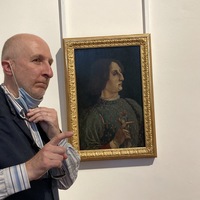
Thomas Cohen
First off: that hat! A pakul, which our journalist son brought me from Kabul. Second: my take on scholarship. Elegance, clarity, zeal for detail, compassion for the folk we study, humility before our pervasive ignorance. Third: the subject -- the cultural and political anthropology of early modern Italy. Fourth: my exposition -- microhistory, macro-play, wit and drama. Fifth: re links here. I don't undermine our struggling journals, or flout laws, so I upload few offprints. But I do give you final drafts in the DRAFT section way way down at the VERY BOTTOM. For published versions, use your library portals or, if marooned, as some of us are, write me at tcohen@yorku.ca and I will try to help you. Do write anyhow; I am keen on friends and allies around the world. As for training and career: Ann Arbor, Harvard (J.H. Parry, Ted Rabb), and then 50 years at York U, Toronto.
Supervisors: J H Parry, Harvard, and less formally T K Rabb
Address: History Department, York University, Toronto
Supervisors: J H Parry, Harvard, and less formally T K Rabb
Address: History Department, York University, Toronto
less
Related Authors
Susanna Mantioni
Università degli studi Roma Tre
Daniele Santarelli
Università della Campania Luigi Vanvitelli
Boci Boci
University of Pecs
Michela Tarallo
Independent Researcher
Pasquale Orsini
Ministero della cultura
Guido Rebecchini
The Courtauld Institute of Art










Uploads
Books by Thomas Cohen
Papers by Thomas Cohen
The volume's chosen theme is sexual. The essay itself concerns a liminal thug, part Jew part Christian, part noble part haunter of the Roman ghetto and fish-market. Although Ludovico is a shady character, he commands a rag-tag band of followers-semi-Jews, Jews, fishmongers, men no less liminal, who join his adventures into callous sex and slipshod violence. Roman low life, a vignette.
Note that, if you go see the issue, that it contains a very lively round-table featuring all the authors and their audience at the original Duke workshop. I cannot post the round-table without the permission of the participants, so I recommend that, if possible, you go find it.
By agreement with Robisheaux, our organizer, this essay, circulated in advance, aimed to provoke discussion. That is why it makes strong, even rash, claims for the utility of microhistory.
The volume is given to the study of oral culture in early modern Italy.
The essay itself brings the close reading habits of microhistory to particular shouts, both medieval and early modern. Shouts, it says, were powerful devices. Their uses were many; they lent themselves to a range of transactions. Moving from particular shouts to shouts in general, the essay ponders what scholars call "emergence," and admires the phase changes that happen with shifts in scale. It ends with a nod to Dante and a meditation of the gyrations of flocks of starlings, and the shock waves that flash through them when a falcon attacks.
The sixteen essays in this anthology are a fascinating collection, good pieces from ten nations on three continents. Lesley and I provided a long introduction on the nature of orality in the medieval and early modern European realm. As I have not consulted her, I have not posted it on Academia.edu. The piece below is my own contribution to the collection. It applies CA: Conversation Analysis, a branch of linguistics, to records of conversations produced by courts of law.
Unfortunately, a long list, 54 corrections and suggestions, sent by me to the editors, never found its way into their hands. For that reason, the French version contains many errors of expression. It is better to use this English original.
This essay explains its genesis at the end: it makes a case for stories, to cultural historians much more given to theory than to telling tales.
The first lines owe a debt, of course, to Snoopy, the frustrated Story Teller typing away on his dog house. It begins with the infamous first line from Lytton Bulwer, worst operner ever and Snoopy's eternal writer's block, and then tries for better.
Note from 2021: The special issue featured art historians and historians of architecture. This postscript aimed to convince readers of a journal of urban history that esthetic matters lent themselves to urban social practices. The beautiful entered readily into a complex gift economy that forged and adjusted social ties.
Note from 2021: The volume collects papers stimulated by, and often ranged against, the famous arguments of Robert Putnam about the weakness of political capital in southern Italy. This essay, against Putnam, sees a great deal of communal feeling and communal practice in a zone far removed from the North Italian cities from which he argues.
Note from 2021: I told the editor I would write an article about love if she allowed me to include a meditation on hatred, its close cousin. Both passions were profoundly political, almost institutional. I stress the gulf between old love and new.
A tale of entrapment, of inter-religious sex, of intrigue and tragedy.
Note from 2021: This paper was to have been a chapter in Love and Death but the book was growing too long. The essay itself is rather long, "too long!" said Eliott Horowitz to me one day at dinner. Eliott was a splendid scholar, a tragic loss to us when he died too young. He may have been right. It is a lively portrait of the ambiguities of Jewish life amidst Christians.
A later version, with a different title (Innocentia and Vespasiano) appears as a chapter in Love and Death
Note from 2021: This is a microhistory that takes on calculated strategies with love, sex, and marriage in mind. The male lover is somewhat an oaf, the wily servant is a slippery character, and the young woman, although victim of them both, comes off as handsomely clever. The denouement turns on a clumsy poem, handsomely remembered. The essay ends with a meditation on sliding sand and flickering flames, as models for life, and love. As for Bordieu, he was not himself in this particular bed, but, goodness knows, habitus was there, between the sheets.
In what follows, you will see a shorter version of what became the first chapter of Love and Death.
In both essays, in the 2002 journal and the 2004 book, I stress the tension between geometry and life, between neat intellectual patterns and calamity, between reason and overwhelming passion.
Once in court, at the trial, the essay swivels to the epistemology of credit and trust among men. It posits three ways of winning fede, faith, credibility. A tense drama full of pain and fear, it is also a lesson in the anthropology of trust.
I return to this story of confrontation in court in my 2015 essay, "Tracking Conversation," but for another pursuit, the history of oral practice.